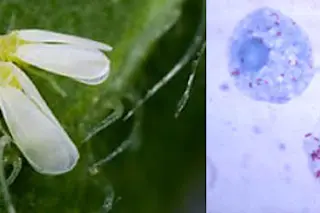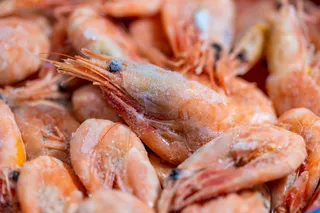Many insects suck the juices of plants, much to the dismay of gardeners and farmers. But plants are more than just a source of food; they’re also a source of bugs for bugs. Ayelet Caspi-Fluger from the Newe-Ya’ar Research Center has found that sap-sucking whiteflies can transfer bacteria into the plants they feed from, and these bacteria can then be picked up by other whiteflies. By plunging their straws into the same jug, the whiteflies can pass beneficial microbes to one another.
Insects carry a wide variety of bacteria inside their tissues, which help them digest their food and even grant them superpowers. These passengers are passed on from mother to youngsters, and across sexual partners. But they must also have ways of jumping across the species barrier, for closely related bacteria are often found in distantly related insects. Plants are an obvious route, but until now, no one has clearly shown that they can channel bacteria from one insect to another. Caspi-Fluger is the first.
She worked with sweet potato whiteflies – a worldwide pest – that carried Rickettsia, a bacterium best known for infecting humans and other back-boned animals. It causes diseases such as typhus and Rocky Mountain spotted fever, and is spread through the bite of blood-sucking arthropods like ticks, fleas and lice. But this is one of many guises: some species can also cause disease in plants like papayas, while others act as helpful hitchhikers that provide insects with nutrients.
Caspi-Fluger allowed Rickettsia-bearing whiteflies to feed on several different plants included cotton, basil and nightshade. Twenty days later, he found the bacteria in their leaves, which were a perfect genetic match for the ones in the whiteflies.
The bacteria didn’t cause any problems for the plant. By using glowing antibodies that stick to Rickettsia, Caspi-Fluger showed that they were confined to tubes called phloem. These juicy nutrient-rich channels are like the arteries and veins of a plant, and they’re what insects like whiteflies feed from. Just as blood-sucking insects like mosquitoes can pick up malarial parasites or dengue viruses by biting infected humans, sap-sucking insects can pick up microbes by piercing the same infected phloem. Caspi-Fluger proved this too: when she released uninfected whiteflies onto the infected plants, they picked up Ricketssia within ten days.
In this study, Caspi-Fluger only worked with whiteflies, but it’s likely that plants could also transmit bacteria to other arthropod groups. After all, the same strains of Rickettsia are also found in aphids, leafhoppers and mites. It will be interesting to see if the bacteria can form a stable relationship with insects that suck it up from plants, and whether it gets passed down from mother to daughters. If so, plants could act as unwitting match-makers that create new lasting alliances between insects and bacteria.
Reference: Caspi-Fluger, Mozes-Daube, Inbar, Katzir, Portnoy, Belausov, Hunter & Zchori-Fein. 2011. Horizontal transmission of the insect symbiont Rickettsia is plant-mediated. Proc Roy Soc B http://dx.doi.org/10.1098/rspb.2011.2095
Photo: whitefly by USDA, Stephen Ausmus














